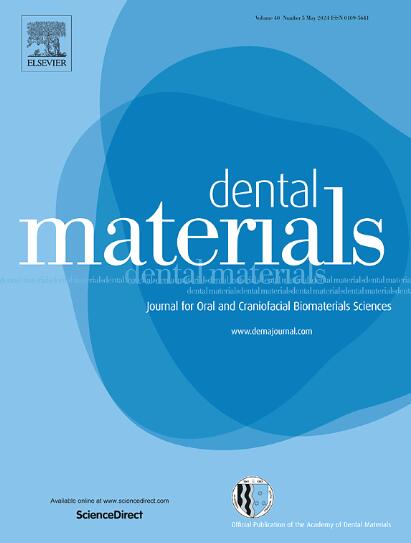pH对磷酸酯单体与氧化锆粘合性能的影响。
IF 4.6
1区 医学
Q1 DENTISTRY, ORAL SURGERY & MEDICINE
引用次数: 0
摘要
目的:含引物的功能磷酸酯单体在牙用粘接剂中应用广泛。本研究旨在分析氧化锆与磷酸酯单体在不同pH条件下(酸性或中性)的原子水平相互作用。方法:采用固态31P核磁共振波谱法研究了两种磷酸酯单体——甘油磷酸二甲基丙烯酸酯(GPDM)和10-甲基丙烯酰氧癸基磷酸二氢(MDP)在不同pH条件下与氧化锆的结合作用。测定了有和没有磷酸酯单体的氧化锆表面的接触角。另外,通过拉伸结合强度(TBS)测试,确定不同pH条件下含磷酸酯单体的引物对氧化锆的影响。结果:固态31P核磁共振显示,GPDM和MDP均表现出增宽的峰,其位置与未反应形式不同,这表明GPDM和MDP中磷酸基团的周围环境在原子水平上随着与氧化锆的粘附而发生变化。酸性的MDP可以通过氧化锆表面的酯化反应与氧化锆形成共价键。与gpdm氧化锆相比,mdp氧化锆具有更高的接触角。在酸性条件下,与氧化锆反应的MDP组TBS最高。意义:这些发现表明磷酸酯单体,特别是在酸性条件下的MDP,可以与氧化锆化学结合,有助于增强粘附行为。本文章由计算机程序翻译,如有差异,请以英文原文为准。
The influence of pH on the adhesive performance of phosphoric ester monomers with zirconia
Objective
Functional phosphoric ester monomers containing primers have been widely used in dental adhesives. This study aims to analyze the atomic-level interaction between zirconia and phosphoric ester monomers under different pH conditions (acidic or neutral).
Methods
Solid-state 31P NMR spectroscopy was employed to investigate the binding interactions between two types of phosphoric ester monomers—glycerophosphate-dimethacrylate (GPDM) and 10-methacryloyloxydecyl dihydrogen phosphate (MDP)—with zirconia under varying pH conditions. Contact angles were measured on the zirconia surfaces with and without the application of phosphoric ester monomers. Additionally, tensile bond strength (TBS) tests were conducted to determine the effects of different phosphoric ester monomer-containing primers under different pH conditions on zirconia.
Results
Solid-state 31P NMR spectroscopy revealed that both GPDM and MDP exhibited broadened peaks, positioned differently from their unreacted forms, indicating that the environment surrounding the phosphate groups in both GPDM and MDP changed upon adhesion to zirconia at the atomic level. Acidic MDP may form covalent bonds with zirconia through additional esterification on the zirconia surface. MDP-primed zirconia demonstrated a higher contact angle than GPDM-primed zirconia. The highest TBS was observed in the group of MDP reacted with zirconia under acidic conditions.
Significance
These findings suggest that phosphoric ester monomers, particularly MDP in acidic conditions, can chemically bind to zirconia, contributing to enhanced adhesion behavior.
求助全文
通过发布文献求助,成功后即可免费获取论文全文。
去求助
来源期刊

Dental Materials
工程技术-材料科学:生物材料
CiteScore
9.80
自引率
10.00%
发文量
290
审稿时长
67 days
期刊介绍:
Dental Materials publishes original research, review articles, and short communications.
Academy of Dental Materials members click here to register for free access to Dental Materials online.
The principal aim of Dental Materials is to promote rapid communication of scientific information between academia, industry, and the dental practitioner. Original Manuscripts on clinical and laboratory research of basic and applied character which focus on the properties or performance of dental materials or the reaction of host tissues to materials are given priority publication. Other acceptable topics include application technology in clinical dentistry and dental laboratory technology.
Comprehensive reviews and editorial commentaries on pertinent subjects will be considered.
 求助内容:
求助内容: 应助结果提醒方式:
应助结果提醒方式:


